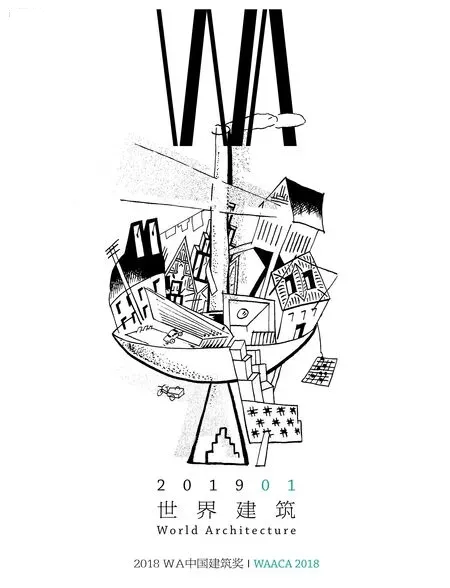青年观察员感言
关飞
中国建筑设计研究院有限公司本土设计研究中心副主任、副总建筑师
WA中国建筑奖由《世界建筑》杂志社在2002年设立之后逐渐成为最受关注的中国非官方建筑奖项之一,走到2018年,WA中国建筑奖无论从奖项设置还是从评审嘉宾的组成来说,无不体现出了多元价值观的取向,逐渐从“小众”走向“大众”。
作为代表“大众”的国企或央企的设计院是国家主导的市场经济体系中的设计机构,总体而言,依然和其他设计组织,尤其是强调设计创意的国内工作室和国外事务所明显不同。国家设计院的技术力量强劲、编制规模宏大、组织结构完备,可以应对各种建筑类型的设计;但在设计理念、设计叙述、设计原创方面,在学术性、学术批评性和文化艺术思想的活跃氛围方面,仍然需要反思自身。从这个维度上看,WA中国建筑奖的批判性对于设计院的“日常”工作是有益的。
王亦知
北京市建筑设计研究院有限公司第四建筑设计院副院长
很荣幸能够作为青年观察员参加WA中国建筑奖的评审。参评的项目类型丰富,从城市尺度的更新到个人尺度的装置,无不涵盖,使我能够暂时摆脱“大院”里相对单一的工作,体验更为广泛的建筑领域;同时,我也欣喜地看到,“体制”之外,设计以更为多元的形式渗入人们生活的方方面面。参观评审的一个更大红利,就是能够现场聆听评委们对这些项目的评议。能够在同一时间接触如此多的大咖,看到他们思想的火花与碰撞,让人受益匪浅。
然而,出于大院工作的思维惯性,我不得不进一步思考涉及建筑品质的诸多要素,如经济性、维护性、可持续性等等,这又把诸多的参评项目压缩成了一个薄片——两块展板所能承载的似乎更多的只有“视觉化”一个维度,这也是现场困扰很多评委的一个问题。
希望WA中国建筑奖坚持现有的广度,同时突破维度的限制,越办越好!
杨旭
深圳市建筑设计研究总院有限公司副总经理、副总建筑师
作为一个非官方的建筑奖,WA中国建筑奖一贯坚持独立的学术判断,试图发现、引导某种清晰的专业价值认同,这与很多官方的奖项不太一样。随着奖项的扩充,WA中国建筑奖也从较为单一的价值取向,转变为对当下中国建筑界多元共存生态的尊重。
作为观察员,我不断地在不同奖项场景中切换,可直面不同奖项参评作品的价值共识、对立甚至冲突;也可聆听评委们礼貌而真诚的沟通、交流甚至辩论。略感遗憾的是,由于缺乏实地考察环节,评委们无法准确判断出参评作品表述的价值取向与现实之间的差距,这可能成为评委们做出判断时的一种无奈。当我们给一座建筑颁一个奖时,是尝试去支持、夯实某种价值认同,并使之在更广泛的领域传播,问题在于对此我们真的有把握吗?
张天钧
华建集团华东建筑设计研究总院建筑创作所设计总监
传统设计院的建筑师,对于WA中国建筑奖的两难态度可能也是“大院”建筑师本身对其社会意义定位的一种状态:既需要在一定规模的功能性建筑的设计中满足社会主流群体的需求,又希望能在建筑学、美学、甚至哲学这些学术领域内进行有意义的探索。很荣幸能以这样的一类建筑师身份参观2018WA中国建筑奖的评审,我也很欣喜地看到传统设计院的一些作品在城市贡献、社会公平方面的努力与热情。无疑,随着城市社会的发展,人们对于公共设施、公共建筑有了更多的关注与需求,而这类项目也越来越多地成为复杂的、牵涉多方的、社会性的设计项目,传统设计院在与政府部门以及其他多方协调这一方面显然具有优势。能够在此类项目中贡献更多的力量,也许是设计院建筑师与WA中国建筑奖共通的价值取向之一。
最后感谢WA编辑部各位的努力与付出,谢谢。
GUAN Fei
Vice Director and Vice President, China Architecture Design and Research Group
The WA Awards for Chinese Architecture(WAACA), established by World Architecture in 2002, has gradually become one of the most attention-grabbing non-official architectural awards in China. As in 2018, the WAACA fully reflects the"orientation of a pluralistic value system" in terms of the award categories and the composition of the judging panel, as well as an evolution from being"niche" to targeting "the masses".
China Architecture Design and Research Group(CAG), a design institute in a state-led market economy, represents "the masses" in terms of being a state-owned/national enterprise. Overall, it differs significantly from other design organisations,especially local studios and foreign firms that emphasise design creativity. With its formidable technical strength, large-scale establishment and complete organisational structure, the design institute can design various types of buildings.Nevertheless, there is still the need for self-reflection in areas, such as design concepts, narratives and originality, and creating a vibrant atmosphere for academic, academically critical and cultural and artistic thoughts. In these dimensions, the criticality of the WAACA is beneficial to the "daily" work of the design institute.
WANG Yizhi
Vice Director, 4th Institute, Beijing Institute of Architectural Design
I was fortunate to participate as a youth observer in the judging sessions of the WAACA. A wide variety of projects were being evaluated there, ranging from urban renewal at a city scale to installations at an individual scale. These sessions temporarily freed me from the relatively single-focus work at the"large institution" and provided me the opportunity to experience the architectural field with a broader perspective. I was delighted to see that outside the"system", design has infiltrated different aspects of people's lives in a more pluralistic form. An even bigger benefit of attending the judging sessions was the opportunity to listen to judges' comments on the participating projects. It was an invaluable experience to be in the presence of several important architectural dignitaries at the same time and to witness them share their thoughts and see passions ignite as they interacted with one another.
However, the habitual mode of working at the large institution led me to think further about the many factors related to building quality,such as economic efficiency, ease of maintenance and sustainability. Doing so reduced the various competing projects into thin boards. After all, the two exhibition panels seemed to mostly portray only a single dimension of "visualisation". This was also a problem that plagued many judges on site.
Hopefully, the WAACA can retain the existing scope of the awards while simultaneously break through the dimensional limitations to achieve greater success!
YANG Xu
Vice General Manager and Deputy Chief Architect,Shenzhen General Institnte of Architectural Design and Research Co., Ltd.
As a non-official architectural award, the WAACA has consistently insisted upon independent academic judgements while attempting to discover and provide guidance for some clear identification of professional values. This characteristic makes it different from many other official awards. With the extension in the scope of the awards, the WAACA has evolved from a relatively single-value orientation to being respectful of the multi-dimensional and co-existing ecology of the present architectural community in China.
As an observer, I was constantly switching between the judging scenarios of the different awards. I witnessed the consensus, opposition, and even conflicts in values during the judgement of the participating projects for the various awards. I was also able to listen in on the courteous and sincere communication, exchanges and occasional debates between the judges. The only slight shortcoming was the lack of a site visit component, such that the judges could not accurately determine the gap between the value orientation expressed by the participating works and the reality. This was a constraint that the judges had to deal with when making their evaluations. When a building is being presented with an award, are we trying to support and consolidate a particular value orientation so that it is propagated to wider fields? Can we be really confident of achieving that?
ZHANG Tianjun
Director, Architectural Creation Department, East China Architectural Design & Research Institnte
Being a traditional design institute, the WAACA quandary that it faces may also be a state in which the large institution's architects align and position themselves with social significance:on the one hand, they must meet the needs of the mainstream groups to a certain extent when designing functional buildings; on the other hand, they also wish to engage in meaningful explorations within the academic fields of architecture, aesthetics and even philosophy. Being in this category of architects, I am honoured to participate in the judging sessions of the 2018 WAACA. At the same time, I am delighted to see the effort and enthusiasm of traditional design institutes toward urban contribution and social equity. Without doubt, people's concerns and demands regarding public facilities and buildings increase as urban society develops. Such design projects have become increasingly complex, make significant social impact and involve multiple parties. Traditional design institutes enjoy some obvious advantages when co-ordinating with government departments and other parties, and they are able to contribute substantially to this type of project. This may perhaps be one of the shared value orientations between architects from design institutes and the WAACA.
Finally, I would like to commend the editorial staff at World Architecture for their hard work and dedication. Thank you.

